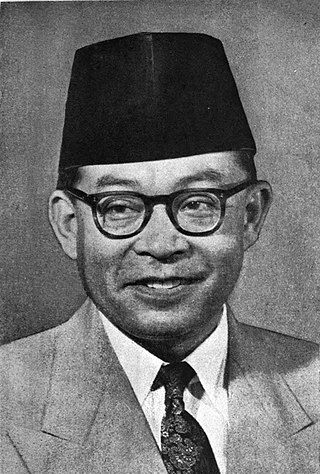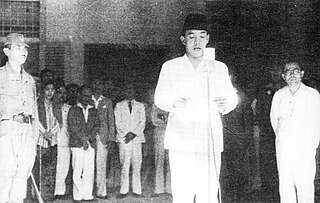
Batavia was the capital of the Dutch East Indies. The area corresponds to present-day Jakarta, Indonesia. Batavia can refer to the city proper or its suburbs and hinterland, the Ommelanden, which included the much larger area of the Residency of Batavia in the present-day Indonesian provinces of Jakarta, Banten and West Java.

Mohammad Hatta was an Indonesian statesman, nationalist, and independence activist who served as the country's first vice president as well as the third prime minister. Known as "The Proclamator", he and a number of Indonesians, including the first president of Indonesia, Sukarno, fought for the independence of Indonesia from the Netherlands. Hatta was an important figure during the Indonesian national awakening and during the national revolution, as a youth he was politically active both in the Netherlands and the Indies, which led him to be imprisoned in the Boven Digoel concentration camp for his activism, he also played a crucial part in the proclamation of Indonesian independence, being second the person to sign the declaration besides Sukarno, thus naming him as one of the founders of Indonesia.

The Proclamation of Indonesian Independence was read at 10:00 Tokyo Standard Time on Friday, 17 August 1945 in Jakarta. The declaration marked the start of the diplomatic and armed resistance of the Indonesian National Revolution, fighting against the forces of the Netherlands and pro-Dutch civilians, until the latter officially acknowledged Indonesia's independence in 1949. The document was signed by Sukarno and Mohammad Hatta, who were appointed president and vice-president respectively the following day.

Sri Sultan Hamengkubuwono IX, often abbreviated as HB IX, was an Indonesian politician and Javanese royal who was the second vice president of Indonesia, the ninth sultan of Yogyakarta, and the first governor of the Special Region of Yogyakarta. Hamengkubuwono IX was also the chairman of the first National Scout Movement Quarter and was known as the Father of the Indonesian Scouts.

The Bogor Palace is one of seven presidential palaces of Indonesia, it is located in the city of Bogor, West Java. The palace is noted for its distinctive architectural and historical features, as well as the adjoining botanical gardens. Istana Bogor was opened to the public in 1968 to public tour groups, with the permission of the acting president of Indonesia, Suharto. The gardens of the palace covers an area of 284,000 square metres.

The Netherlands Indies guilder was the unit of account of the Dutch East Indies from 1602 under the United East India Company, following Dutch practice first adopted in the 15th century. A variety of Dutch, Spanish and Asian coins were in official and common usage. After the collapse of the VOC at the end of the 18th century, control of the islands reverted to the Dutch government, which issued silver 'Netherlands Indies' guilder and fractional silver and copper coins until Indonesian independence in 1945.

Jakarta is Indonesia's capital and largest city. Located on an estuary of the Ciliwung River, on the northwestern part of Java, the area has long sustained human settlement. Historical evidence from Jakarta dates back to the 4th century CE, when it was a Hindu settlement and port. The city has been sequentially claimed by the Indianized kingdom of Tarumanegara, the Hindu Kingdom of Sunda, the Muslim Sultanate of Banten, and by Dutch, Japanese and Indonesian administrations. The Dutch East Indies built up the area before it was taken during World War II by the Empire of Japan and finally became independent as part of Indonesia.

Totok is an Indonesian term of Javanese origin, used in Indonesia to refer to recent migrants of Arab, Chinese, or European origins. In the eighteenth and nineteenth centuries it was popularised among colonists in Batavia, who initially coined the term to describe the foreign born and new immigrants of "pure blood" – as opposed to people of mixed indigenous and foreign descent, such as the Peranakan Arabs, Chinese or Europeans.

Djuanda Kartawidjaja, more commonly referred to mononymously as Djuanda, was an Indonesian politician and technocrat who held various positions during the presidency of Sukarno, most notably as prime minister of Indonesia and a cabinet minister in several cabinets.

The Dutch East Indies, also known as the Netherlands East Indies, was a Dutch colony with territory mostly comprising the modern state of Indonesia, which declared independence on 17 August 1945. Following the Indonesian War of Independence, Indonesia and the Netherlands made peace in 1949. In the Anglo-Dutch Treaty of 1824, the Dutch ceded the governorate of Dutch Malacca to Britain, leading to its eventual incorporation into Malacca (state) of modern Malaysia.

Robert Nieuwenhuys was a Dutch writer of Indo descent. The son of a 'Totok' Dutchman and an Indo-European mother, he and his younger brother Roelof, grew up in Batavia, where his father was the managing director of the renowned Hotel des Indes.

Dutch Indies literature or Dutch East Indies literature is the Dutch language literature of colonial and post-colonial Indonesia from the Dutch Golden Age to the present day. It includes Dutch, Indo-European and Indonesian authors. Its subject matter thematically revolves around the VOC and Dutch East Indies eras, but also includes the postcolonial discourse.
Frans Johan Louwrens Ghijsels was a Dutch architect and urban planner who worked in the Netherlands and the Dutch Indies. Ghijsels was the founder of AIA, the biggest architecture consultant in the Dutch Indies. He was one of the instrumental architects in developing a modern style characteristic of the Dutch Indies.

Elisabeth Wilhelmina Johanna (Betty) Couperus-Baud, was a Dutch translator. She was the wife of the Dutch writer Louis Couperus (1863–1923).

John Ricus Couperus was a Dutch lawyer, member of the Council of Justice in Padang, member of the High Military Court of the Dutch East Indies and the landheer of Tjikopo. He was also the father of the Dutch writer Louis Couperus and knight in the Order of the Netherlands Lion.

Ecstasy: A Study of Happiness is a novel written by Louis Couperus and published in 1892 by L.J. Veen in a first edition of 1,250–1,500 copies. A second edition was printed in 1894 and a third in 1905. Ecstasy was the first book of Couperus that was published by L.J. Veen, later his regular publisher. Couperus received a wage of 550 guilders for the first edition. Ecstasy was first published in the Dutch literary magazine The Gids. The book was translated into English by Alexander Teixeira de Mattos in 1919 and published by Dodd, Mead and Company.

Williswinde is a collection of verses written by Dutch writer Louis Couperus. The first edition was published by L.J. Veen in 1895. In 1904 Veen acquired full rights of Williswinde and 16 other works that were written by Couperus. For the first edition in 1894 Couperus received 200 guilders and the poems by that time had already been published in a number of Dutch newspapers and magazines. However Couperus had some difficulty to get the poem Williswinde published, as he wrote in a letter to a colleague, Smit Kleine. The book cover was designed by painter Ludwig Willem Reymert Wenckebach.

Kiai Haji Zainul Arifin was an Indonesian politician who served as deputy prime minister of Indonesia, 2nd Speaker of the DPR, and a leading figure of the Nahdlatul Ulama.

Rear Admiral Tadashi Maeda was a high-ranking Imperial Japanese Navy officer during the Pacific War. Maeda played an important role in Indonesian independence; he met Sukarno and Mohammad Hatta at his house in Jakarta on 16 August 1945 and his house was used for drafting the Proclamation of Indonesian Independence. After leaving military service, Maeda worked in the oil industry.
Gedung Joang '45 is a historical museum in Jakarta, which tells the history of the Indonesian struggle for independence from Dutch colonial rule and the formation of the state of Indonesia.


















